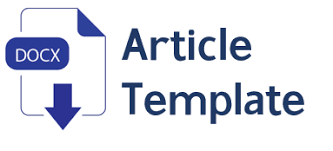PENGARUH TANGIBLE TERHADAP LOYALITAS PELANGGAN DI AULINA LAUNDRY BATAM
DOI:
https://doi.org/10.59193/jmr.v2i1.151Abstract
This research aims to determine the effect of tangible on customer loyalty at Aulina laundry Batam. The research method used is a quantitative research method. The data collection technique used is a survey technique with research instruments in the form of a questionnaire. The sample used was based on the slovin formula from a population of 297 and a sample of 84 customers from the entire population who were considered to represent the research data. Data analysis used quantitative descriptive analysis and simple linear analysis. The results of the research show that all statement items are valid and reliable. Hypothesis testing shows the significance value of the coefficients table, obtained T count 0.000 > 0.05 also the distribution list and a real level of 5% obtained Tcount 6.694 > T table 1.989 stating Ha is accepted Ho is rejected. The R2 test shows that the tangible variable has an effect of 0.604 or 60.4% on customer loyalty, the remaining 39.6% is influenced by other variables. So it can be concluded that the tangible variable (X) has a significant effect on customer loyalty (Y).
Downloads
References
BPS. 2021. Kota Batam dalam Angka (Batam Municipality in Figures). Batam:Badan Pusat Statistik Kota Batam.
Jill, Griffin. 2020. Customer Loyalty.
Sugiyono. 2015. Metode Penelitian Kuantitatif, Kualitatif, Dan R&D. Bandung. Alfabeta.
Tjiptono, Fandi. 2018. Manajemen Jasa. Yogyakarta: Andi Offset.
Anjardiansyah, dkk. 2019. Pengaruh Lokasi, Hargersitaa, Dan Physical Evidence Terhadap Loyalitas Konsumen Menggunakan Lapangan Griya Futsal di Kota Pontianak. Jurnal Produktivitas. Vol 6.
Aptaguna dan Pitaloka. 2016. Pengaruh Kualitas Pelayanan dan Harga Terhadap Minat Beli Jasa Go-jek. Jurnal Widyakala. Vol 3.
Bambang, dkk. 2020. Penurunan Kadar Fosfat Air Limbah Laundry Menggunakan Kolom Adsorpsi Media Granular Activated Carbon. Jurnal SDA dan Lingkungan. Vol 7. No 1.
Basyir, Muhammad. 2020. Pengaruh Physical Evidence Terhadap Loyalitas Nasabah Bank Syariah: Peran Kepuasan Sebagai Variabel Pondasi. Jurnal Ekonomi dan Manajemen Teknologi. Vol 4. No 2.
Cucu dan Dini. 2019. Analisis Kepuasan Konsumen Untuk Meningkatkan Volume Penjualan Kedai Kopi Kala Senja. Jurnal Ekonomi Bisnis. Vol 3. No 2.
May Sara, dkk. 2017. Pengaruh Physical Evidence Terhadap Keputusan Pembelian Konsumen di Café Infinito Culinary Bandung. Jurnal Gastronomi Pariwisata. Vol 3. No 2.
Muhammad Ifan, dkk. 2018. Pengaruh Proses dan Bukti Fisik Terhadap Kepuasan Konsumen di Hotel Santika Bandung. Jurnal Riset Bisnis dan Manajemen. Vol 8. No 2.
Muhammad, Thaat. 2019. Standard Operating Procedure Guest Laundry di Harris Hotel & Conventions Surabaya. Jurnal Penelitian.
Mujiati, Hanif. 2014. Analisis dan Perancangan Sistem Informasi Stok Obat Pada Apotek Arjowinangun. Speed Journal Sentra Penelitian Enginering dan Edukasi. Vol 11. No 2.
Suciati, Lia Anjani. 2019. Analisis Kualitas Produk dan Kualitas Pelayanan Terhadap Kepuasan Pelanggan Pada Industri Kecil Menengah Batik (Studi Kasus Pada CV. Batik Marem, Lumajang)
Sulaksono, Agung. 2011. Pengaruh Physical Evidence Terhadap Loyalitas Konsumen Café Rocketz Solo. Skripsi. Universitas Sebelas Maret. Susanti dan Angelia. 2021. Persepsi Konsumen Terhadap Kualitas Produk Sabun Lifebuoy di Kota Pontianak. Jurnal Ekonomi Pembangunan, Manajemen dan Bisnis Akuntasi. Vol 1. No 2.
Trisno, Musanto. 2005. Faktor-Faktor Kepuasan Pelanggan dan Loyalitas Pelanggan : Studi Kasus Pada CV Sarana Media Advertising Surabaya.
Website
Jaringan Dokumentasi dan Informasi hukum Pemko Batam. 2019. Sejarah Batam. 2019.( https://jdih.batam.go.id/?cat=3
Downloads
Published
How to Cite
Issue
Section
License
Copyright (c) 2023 Wan Abdurrahman Wan, Andri Wibowo

This work is licensed under a Creative Commons Attribution 4.0 International License.











